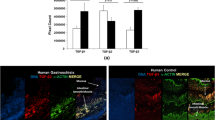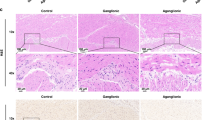Abstract
Background
Gastrointestinal (GI) motility disorders represent a group of problems that more constantly encountered in preterm infants. However, whether hypoxia exposure contributes to the GI dysfunctions is still unclear.
Methods
Newborn mice were exposed to hypoxia (10%) from P1 to P7. Intestinal motilities were examined by a strain gauge transducer. The proliferation of ICCs was detected by using immunostaining for BrdU, Ki67, Kit, Ano1, and insulin-like growth factor 1 receptor (IGF-1R+). Smooth muscle cells and enteric neurons were revealed by immunostaining for α-SMA and NF200, respectively. Apoptosis was assessed by TUNEL assay. Kit signal pathway was examined by western blot and qPCR.
Results
Intestinal motilities were found weakened significantly in the hypoxic small intestines as compared to controls on P8. Kit+ or Ano1+ interstitial cells of Cajal (ICCs) were found obviously decreased in the myenteric ICCs (ICC-MY) of neonatal mice after exposed to hypoxia. A large number of ICC progenitors (IGF-1R+) were found highly mitotic (BrdU+ Ki67+) to populate ICC during early postnatal development in the normoxic mice. We found the ICC proliferation was significantly inhibited upon hypoxia exposure, without increasing apoptosis (TUNEL+). We next identified that Kit phosphorylation was inhibited 3 days after hypoxia exposure. The inhibition of Kit signaling was largely due to decreased the expression of the ligand of Kit receptor, stem cell factor (SCF), in the intestinal walls. Exposure to imatinib, a Kit receptor inhibitor, for 3 days from P4 phenocopied the effect of hypoxia on the neonatal pups that resulted in inhibited intestinal motilities and decreased Kit+ ICC numbers.
Conclusion
All together, our findings indicate the SCF/Kit signaling insufficiency may contribute to the underdevelopment of ICCs and intestinal motility dysfunction upon hypoxia exposure. The decease in ICC density is likely due to the cell cycle arrest of ICC progenitor cells.






Similar content being viewed by others
Abbreviations
- ICCs:
-
Interstitial cells of Cajal
- SCF:
-
Stem cell factor
- IGF-1R:
-
Insulin-like growth factor 1 receptor
- GI:
-
Gastrointestinal
References
Carlson SJ, Chang MI, Nandivada P, Cowan E, Puder M. Neonatal intestinal physiology and failure. Semin Pediatr Surg. 2013;22:190–194.
Lu X, Zhao J, Gregersen H. Small intestinal morphometric and biomechanical changes during physiological growth in rats. J Biomech. 2005;38:417–426.
So AKW, Ng PC, Fok TF. Gastrointestinal dysmotility in preterm infants. HK J Paediatr. 2003;8:101–106.
Sangild PT, Petersen YM, Schmidt M, et al. Preterm birth affects the intestinal response to parenteral and enteral nutrition in newborn pigs. J Nutr. 2002;132:3786–3794.
Szurszewski J, Steggerda FR. The effect of hypoxia on the mechanical activity of the canine small intestine. Am J Dig Dis. 1968;13:178–185.
Beckett EAH, Horiguchi K, Khoyi M, Sanders KM, Ward SM. Loss of enteric motor neurotransmission in the gastric fundus of Sl/Sl(d) mice. J Physiol. 2002;543:871–887.
Ward SM. Interstitial cells of Cajal in enteric neurotransmission. Gut. 2000;47:iv40–iv43 (Discussion iv52).
Burns AJ, Lomax AE, Torihashi S, Sanders KM, Ward SM. Interstitial cells of Cajal mediate inhibitory neurotransmission in the stomach. Proc Natl Acad Sci USA. 1996;93:12008–12013.
Ward SM, Beckett EA, Wang X, Baker F, Khoyi M, Sanders KM. Interstitial cells of Cajal mediate cholinergic neurotransmission from enteric motor neurons. J Neurosci. 2000;20:1393–1403.
Langton P, Ward SM, Carl A, Norell MA, Sanders KM. Spontaneous electrical activity of interstitial cells of Cajal isolated from canine proximal colon. Proc Natl Acad Sci. 1989;86:7280–7284.
Goyal RK, Chaudhury A. Mounting evidence against the role of ICC in neurotransmission to smooth muscle in the gut. Am J Physiol Gastrointest Liver Physiol. 2010;298:G10–G13.
Goyal RK. CrossTalk opposing view: interstitial cells are not involved and physiologically important in neuromuscular transmission in the gut. J Physiol. 2016;594:1511–1513.
Shaylor LA, Hwang SJ, Sanders KM, et al. Convergence of inhibitory neural inputs regulate motor activity in the murine and monkey stomach. Am J Physiol Gastrointest Liv Physiol. 2016;311:G838–G851.
Lu Z, Ku L, Chen Y, Feng Y. Developmental abnormalities of myelin basic protein expression in fyn knock-out brain reveal a role of Fyn in posttranscriptional regulation. J Biol Chem. 2005;280:389–395.
Mei F, Zhu J, Guo S, et al. An age-dependent proliferation is involved in the postnatal development of interstitial cells of Cajal in the small intestine of mice. Histochem Cell Biol. 2009;131:43–53.
Han J, Shen W-H, Jiang Y-Z, et al. Distribution, development and proliferation of interstitial cells of Cajal in murine colon: an immunohistochemical study from neonatal to adult life. Histochem Cell Biol. 2010;133:163–175.
He X, Yang W, Wen X, et al. Late embryonic and postnatal development of interstitial cells of cajal in mouse esophagus: distribution, proliferation and kit dependence. Cells Tissues Organs. 2012;196:175–188.
Liu LW, Thuneberg L, Huizinga JD. Development of pacemaker activity and interstitial cells of Cajal in the neonatal mouse small intestine. Dev Dyn. 1998;213:271–282.
Faussone-Pellegrini MS, Matini P, Stach W. Differentiation of enteric plexuses and interstitial cells of Cajal in the rat gut during pre- and post-natal life. Cell Tissues Organs. 1996;155:113–125.
Daniel EE, Wang YF. Control systems of gastrointestinal motility are immature at birth in dogs. Neurogastroenterol Motil. 1999;11:375–392.
Zeitouni NE, Chotikatum S, von Köckritz-Blickwede M, Naim HY. The impact of hypoxia on intestinal epithelial cell functions: consequences for invasion by bacterial pathogens. Mol Cell Pediatr. 2016;3:14.
Richburg DA, Kim JH. Real-time bowel ultrasound to characterize intestinal motility in the preterm neonate. J Perinatol. 2013;33:605–608.
Berseth CL. Neonatal small intestinal motility: motor responses to feeding in term and preterm infants. J Pediatr. 1990;117:777–782.
Berseth CL. Gestational evolution of small intestine motility in preterm and term infants. J Pediatr. 1989;115:646–651.
Radenković G, Nikolić I, Todorović V. Interstitial cells of Cajal—pacemakers of the intestinal musculature. FACTA Univ Ser Med Biol. 2005;12:1–5.
Koh SD, Sanders KM, Ward SM. Spontaneous electrical rhythmicity in cultured interstitial cells of cajal from the murine small intestine. J Physiol. 1998;513:203–213.
Der-Silaphet T, Malysz J, Hagel S, Arsenault AL, Huizinga JD. Interstitial cells of Cajal direct normal propulsive contractile activity in the mouse small intestine. Gastroenterology. 1998;114:724–736.
Barajas-López C, Berezin I, Daniel EE, Huizinga JD. Pacemaker activity recorded in interstitial cells of Cajal of the gastrointestinal tract. Am J Physiol. 1989;257:C830–C835.
Mei F, Guo S, He Y, et al. Apoptosis of interstitial cells of Cajal, smooth muscle cells, and enteric neurons induced by intestinal ischemia and reperfusion injury in adult guinea pigs. Virchows Arch. 2009;454:401–409.
Rømert P, Mikkelsen HB. c-kit immunoreactive interstitial cells of Cajal in the human small and large intestine. Histochem Cell Biol. 1998;109:195–202.
Wester T, Eriksson L, Olsson Y, Olsen L. Interstitial cells of Cajal in the human fetal small bowel as shown by c-kit immunohistochemistry. Gut. 1999;44:65–71.
Gao J, Sathar S, O’Grady G, Han J, Cheng LK. Developmental changes in postnatal murine intestinal interstitial cell of cajal network structure and function. Ann Biomed Eng. 2014;42:1729–1739.
Gomez-Pinilla PJ, Gibbons SJ, Bardsley MR, et al. Ano1 is a selective marker of interstitial cells of Cajal in the human and mouse gastrointestinal tract. Am J Physiol Gastrointest Liver Physiol. 2009;296:G1370–G1381.
Hwang SJ, Blair PJA, Britton FC, et al. Expression of anoctamin 1/TMEM16A by interstitial cells of Cajal is fundamental for slow wave activity in gastrointestinal muscles. J Physiol. 2009;587:4887–4904.
Torihashi S, Nishi K, Tokutomi Y, Nishi T, Ward S, Sanders KM. Blockade of Kit signaling induces transdifferentiation of interstitial cells of Cajal to a smooth muscle phenotype. Gastroenterology. 1999;117:140–148.
Chen ZH, Zhang YC, Jiang WF, et al. Characterization of interstitial Cajal progenitors cells and their changes in Hirschsprung’s disease. PLoS ONE. 2014;9:e86100.
Lorincz A, Redelman D, Horváth VJ, Bardsley MR, Chen H, Ordög T. Progenitors of interstitial cells of cajal in the postnatal murine stomach. Gastroenterology. 2008;134:1083–1093.
Huizinga JD, Thuneberg L, Klüppel M, Malysz J, Mikkelsen HB, Bernstein A. W/kit gene required for interstitial cells of Cajal and for intestinial pacemaker activity. Nature. 1995;373:347–349.
Wu JJ, Rothman TP, Gershon MD. Development of the interstitial cell of Cajal: origin, kit dependence and neuronal and nonneuronal sources of kit ligand. J Neurosci Res. 2000;59:384–401.
Ward SM, Burns AJ, Torihashi S, Sanders KM. Mutation of the proto-oncogene c-kit blocks development of interstitial cells and electrical rhythmicity in murine intestine. J Physiol. 1994;480:91–97.
Young HM, Torihashi S, Ciampoli D, Sanders KM. Identification of neurons that express stem cell factor in the mouse small intestine. Gastroenterology. 1998;115:898–908.
Ward SM, Burns AJ, Torihashi S, Harney SC, Sanders KM. Impaired development of interstitial cells and intestinal electrical rhythmicity in steel mutants. Am J Physiol. 1995;269:C1577–C1585.
Mikkelsen HB, Malysz J, Huizinga JD, Thuneberg L. Action potential generation, Kit receptor immunohistochemistry and morphology of steel-Dickie (S1/S1(d)) mutant mouse small intestine. Neurogastroenterol Motil. 1998;10:11–26.
Han J, Zhou Y-P, Jiang Y-Z, He Y-T, Mei F. Postnatal development of interstitial cells of Cajal in mouse colon in response to Kit signal blockade with Imatinib (Glivec®). Acta Histochem. 2010;112:215–221.
Zhou Y-P, He Y-T, Chen C-L, et al. Time-specific blockade of PDGFR with Imatinib (Glivec®) causes cataract and disruption of lens fiber cells in neonatal mice. Virchows Arch. 2011;458:349–356.
Yamataka A, Ohshiro K, Kobayashi H, et al. Abnormal distribution of intestinal pacemaker (c-kit-positive) cells in an infant with chronic idiopathic intestinal pseudoobstruction. J Pediatr Surg. 1998;33:859–862.
Kenny SE, Vanderwinden JM, Rintala RJ, et al. Delayed maturation of the interstitial cells of Cajal: a new diagnosis for transient neonatal pseudoobstruction. Report of two cases. J Pediatr Surg. 1998;33:94–98.
Rolle U, Piotrowska AP, Nemeth L, Puri P. Altered distribution of interstitial cells of Cajal in Hirschsprung disease. Arch Pathol Lab Med. 2002;126:928–933.
Vanderwinden J, Rumessen J, Liu H, Descamps D, De Laet M, Vanderhaeghen J. Interstitial cells of Cajal in human colon and in Hirschsprung’s disease. Gastroenterology. 1996;111:901–910.
Mei F, Yu B, Ma H, Zhang H, Zhou D. Interstitial cells of Cajal could regenerate and restore their normal distribution after disrupted by intestinal transection and anastomosis in the adult guinea pigs. Virchows Arch. 2006;449:348–357.
Mei F, Han J, Huang Y, Jiang Z-Y, Xiong C-J, Zhou D-S. Plasticity of interstitial cells of cajal: a study in the small intestine of adult Guinea pigs. Anat Rec. 2009;292:985–993.
Acknowledgments
This work was supported in part by the National Natural Science Foundation of Chongqing (CSTC2012jjA10115).
Author information
Authors and Affiliations
Corresponding authors
Ethics declarations
Conflict of interest
The authors declare that they have no conflict of interest.
Rights and permissions
About this article
Cite this article
Ren, H., Han, J., Li, Z. et al. Stem Cell Factor/Kit Signal Insufficiency Contributes to Hypoxia-Induced Intestinal Motility Dysfunctions in Neonatal Mice. Dig Dis Sci 62, 1193–1203 (2017). https://doi.org/10.1007/s10620-017-4533-y
Received:
Accepted:
Published:
Issue Date:
DOI: https://doi.org/10.1007/s10620-017-4533-y




